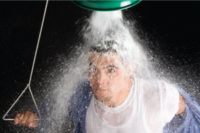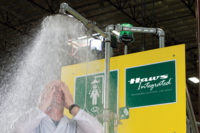The 12 most common causes of emergency eyewash & shower noncompliance

Photos courtesy of Haws Integrated™
For the first time in 25 years, OSHA penalties have significantly increased – by approximately 80 percent. Increased penalties began August 1, 2016 in all states regulated by OSHA.
It’s time to ensure your workplace safety programs and emergency response equipment meet the ANSI Standard that OSHA references for compliance violations. OSHA references the ANSI Z358.1 Standard for emergency shower and eyewash equipment for the proper selection, installation, operation and maintenance of equipment.
OSHA citations increasingly include emergency eyewash and shower equipment issues. Citations are referenced under OSHA 29 CFR 1910.151(c) where employees were exposed to injurious corrosive materials and suitable facilities for quick drenching or flushing of the eyes and body were not provided for immediate emergency use. Facilities cited are not industries (e.g. refineries, petrochemical, etc.) associated with needing emergency response equipment. You must identify hazards in any industry.
Serious violations
The violations are initially being categorized as serious, defined as “when the workplace hazard could cause an accident or illness that would most likely result in death or serious physical harm.” This classification assumes the employer was aware of the type of violation, but did not take corrective action.
• Food Manufacturing Facility: A 2013 citation fined the facility for not providing emergency shower or eyewash stations in the immediate vicinity where employees are required to charge forklift batteries. The facility was required to add equipment to both the shipping and receiving docks. The proposed penalty was listed at $4,000; with the recent fine increase, that same fine would amount to $7,200.
• Logistics Facility: A 2015 citation lists the penalty as exposing employees to corrosive anhydrous ammonia in the engine room without access to a functioning emergency safety shower. The fine was listed at $6,000, which would yield $10,800 after the August date.
Repeat violations
Repeat violations for previously cited emergency shower and eyewash violations for the same or substantially similar conditions are on the rise.
• Nursery & Garden Center: Initial violation of exposure to hazardous cleaning chemicals was cited in June 2015 but was not remedied by the time of re-inspection in November 2015. The 2015 penalty was set at $25,000; the revised penalty would now exceed $40,000.
• Dry Cleaning Facility: A January 2015 citation referenced employee exposure to health hazards associated with using acidic and caustic chemicals in cleaning equipment without any emergency shower or eyewash available. The second violation in August 2015 listed a $6,160 fine; the current revised level would equal $11,088.
Noncompliance causes
These penalties cover commonplace issues, regardless of the industry: non-functioning units to improper selection of products to lack of access to a unit. In the field are many additional non-compliance issues that prevent an emergency response unit from proper functioning, or functioning at all -- increasing the facility’s risk in an emergency.
The 12 most common causes for emergency showers and eyewashes ANSI Z358.1 Standard non-compliance are:
1 Improperly installed or missing dust covers - This exposes the nozzles or outlets to airborne contaminants which can ultimately make their way into a victim’s eyes and exacerbate the issue.
2 Lack of proper signage on the equipment or lack of acceptable lighting - Although this does not affect the unit’s ability to perform, it can prevent a victim from finding the shower or eyewash during an emergency.
3 Providing the improper equipment for the application - A situation where an eyewash has been installed when an eye/face wash or combination shower is the correct solution -- which in turn limits appropriate response needs and could reduce the unit’s effectiveness for the victim.
4 Obstructions in the path of travel to a shower and/or eyewash - Examples include hoses, boxes, etc. This could prohibit a victim from being able make their way to the safety equipment, thus inhibiting its use or possibly leading to a trip or fall and the risk of further injury.
5 Improper installation of eyewash nozzles, actuators and showerheads - Incorrect placement or assembly could result in an inadequate emergency response, potentially causing further injury.
6 Parts of a unit, such as the pull rod or push flag, in a dysfunctional, non-usable state - This could create a situation where a victim is unable to use the equipment when needed and could exacerbate the emergency situation.
7 Lack of flow control to the eye or eye/face wash including erratic, inconsistent or unpredictable water flow - Practicing ophthalmologists say comfortable water pressure is important and should be provided to a victim with the expectation that they will be flushing for a full 15 minutes. This is commonly seen pertaining to showerheads as well.
8 Insufficient water pressure or flow rate - With not enough water pressure or flow, the eye, eye/face wash and/or shower can be considered unusable and may not provide proper flushing capabilities to a user with chemicals or harmful substances on their body.
9 Uneven flow patterns - The eyewash is not capable of providing flushing fluid to both eyes simultaneously. This is considered non-compliant as the standard requires that a controlled flow be provided to both eyes.
10 Improper alignment - Regarding combination units, a common compliance issue is improper alignment. Many times, the showerhead is not in alignment with the eye or eye/face wash and vice versa, not allowing for simultaneous use of the shower and eyewash by the same user.
11 Does not maintain flow rates for simultaneous use when the shower and eyewash are both activated - The most common reason for non-compliance is the inability of the equipment to maintain required flow rates when both the shower and the eye/face wash are activated at the same time – a requirement of the standard since 2009. The eye/face wash may meet all flow requirements when activated alone, but once the shower is activated, flow to the eye/face wash is often impacted, making the unit no longer compliant.
12 Not providing tepid water - As of 2004, the ANSI Standard incorporated the tepid water requirement, yet many existing and new units have yet to comply. All showers and eyewashes must provide tepid water in between 60-100 degrees Fahrenheit or 16-38 degrees Celsius.
The right product and right placement is crucial in a rushed, emergency situation. Increased OSHA fines and citations underscore that all components of an emergency plan are important and should be addressed with equal attention. Financial ramifications are secondary to the victim consequences from a dysfunctional or inadequate emergency eyewash and shower solution.
Looking for a reprint of this article?
From high-res PDFs to custom plaques, order your copy today!






